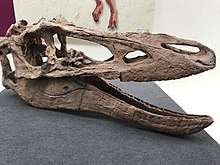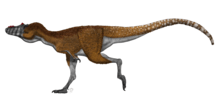Qianzhousaurus
Qianzhousaurus (meaning "Qianzhou lizard") is a genus of tyrannosaurid dinosaurs that lived in Asia during the Late Cretaceous period. There is currently only one species named, the type species Qianzhousaurus sinensis which is member of the tribe Alioramini within the group, and most closely related to Alioramus, another alioramin.
| Qianzhousaurus | |
|---|---|
 | |
| Restored skull cast at Japan | |
| Scientific classification | |
| Kingdom: | Animalia |
| Phylum: | Chordata |
| Clade: | Dinosauria |
| Clade: | Saurischia |
| Clade: | Theropoda |
| Family: | †Tyrannosauridae |
| Subfamily: | †Tyrannosaurinae |
| Tribe: | †Alioramini |
| Genus: | †Qianzhousaurus Lü et al., 2014 |
| Type species | |
| †Qianzhousaurus sinensis Lü et al., 2014 | |
History of discovery
The holotype specimen, GM F10004, was unearthed in southern China, Ganzhou, at the Nanxiong Formation in the summer of 2010 during the construction of an industrial park and it was first described by paleontologists Junchang Lü, Laiping Yi, Stephen L. Brusatte, Ling Yang, Hua Li and Liu Chen in the journal Nature Communications on 2014. The genus is known from a partial sub-adult individual consisting of a nearly complete skull with the lower jaws missing all teeth (lost during fossilization), 9 cervical vertebrae, 3 dorsal vertebrae, 18 caudal vertebrae, both scapulocoracoids, partial ilia, and the left hindlimb compromising the femur, tibia, fibula, astragalus with calcaneum, and metatarsals III and IV. The generic name, Qianzhousaurus, is in reference to Qianzhou (the older name of Ganzhou) where the remains were discovered, and the specific name, sinensis, is derived from the Greek Σῖναι (sin, sino, sinai) in reference to China.[1] The fossil remains were discovered by workmen at a construction site near the city of Ganzhou, who then took them to a local museum.[2]
Lead author Lü Junchang from the Institute of Geology, Chinese Academy of Geological Sciences stated that "the new discovery is very important. Along with Alioramus from Mongolia, it shows that the long-snouted tyrannosaurids were widely distributed in Asia. Although we are only starting to learn about them, the long-snouted tyrannosaurs were apparently one of the main groups of predatory dinosaurs in Asia."[3] The existence of long-snouted tyrannosaurs was previously suspected due to other inconclusive fossil finds, that could be explained as the juveniles of short-snouted species, but co-author Stephen L. Brusatte from the University of Edinburgh reveals that the find "tells us pretty unequivocally that these long-snouted tyrannosaurs were a real thing. They were a different breed, living right at the end of the age of dinosaurs."[4]
Description
Qianzhousaurus were medium-sized tyrannosaurids that have been estimated to be 6.3 m (21 ft) long and 757 kg (1,669 lb) in weight.[1][5] The taxon can be differentiated from other tyrannosaurids in having a highly narrowed premaxilla, a pneumatic opening on the upper extension of the maxilla, and the lack of a vertical ridge-like structure on the lateral surface of the ilium.[1]
Unlike more "traditional" tyrannosaurids, which had prominent deep-set jaws and thick teeth, Qianzhousaurus had a particularly elongated snout, with (when restored) narrow teeth. The holotype specimen is notably more larger and mature than the holotypes of both species of Alioramus, however, given that some sutures between the cervical and dorsal vertebrae are partially fused, the holotype was a immature animal, likely a sub-adult. Qianzhousaurus were leggy animals with a 70 cm (700 mm) long femur and 76 cm (760 mm) long tibia.[1]
Classification
The discovery of Qianzhousaurus led to a new branch of the tyrannosaur family being named, consisting of the long-snouted Q. sinensis and the two known species of Alioramus. This clade, named the Alioramini, had an uncertain placement relative to other members of the tyrannosaur branch in the initial analysis that discovered it. The primary phylogenetic analysis found Alioramini to be closer to Tyrannosaurus than to Albertosaurus, and therefore a member of the group Tyrannosaurinae. However, a second analysis in the same paper found it to be located outside of the clade including Albertosaurinae and Tyrannosaurinae, and therefore the sister group of Tyrannosauridae. Below is the first analysis found by the authors:[1]

| Tyrannosauridae |
| |||||||||||||||||||||||||||||||||||||||||||||
See also
References
- Lü, J.; Yi, L.; Brusatte, S. L.; Yang, L.; Chen, L. (2014). "A new clade of Asian Late Cretaceous long-snouted tyrannosaurids". Nature Communications. 5 (3788). Bibcode:2014NatCo...5.3788L. doi:10.1038/ncomms4788. PMID 24807588.
- Dinosaurs (2014-05-07). "Long-nosed 'Pinocchio rex' dinosaur discovered by scientists". London: Telegraph. Retrieved 2014-05-22.
- "Qianzhousaurus sinensis: Long-Snouted Tyrannosaur Discovered in China | Paleontology". Sci-News.com. 2014-05-07. Retrieved 2014-05-22.
- Jacqueline Howard (2014-05-07). "'Pinocchio Rex' Dinosaur Unearthed In China Confirms Theory About Tyrannosaurs". Huffingtonpost.com. Retrieved 2014-05-22.
- Molina-Pérez, R.; Larramendi, A. (2016). Récords y curiosidades de los dinosaurios Terópodos y otros dinosauromorfos. Barcelona, Spain: Larousse. p. 266. ISBN 9788416641154.


















